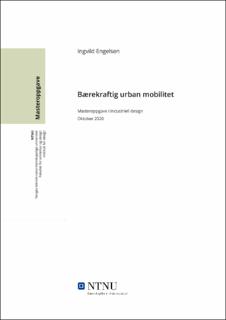| dc.contributor.advisor | Keitsch, Martina | |
| dc.contributor.author | Engelsen, Ingvild | |
| dc.date.accessioned | 2021-09-14T16:51:17Z | |
| dc.date.available | 2021-09-14T16:51:17Z | |
| dc.date.issued | 2020 | |
| dc.identifier | no.ntnu:inspera:54991708:17655360 | |
| dc.identifier.uri | https://hdl.handle.net/11250/2776822 | |
| dc.description.abstract | I Oslo står transportsektoren for over 60% av alle klimagassutslipp, der personbilen bidrar med nesten 40%. Samtidig sitter Osloborgere mest i kø i Norden, og ettermiddagsrushet er verre enn i London. I tillegg forventes befolkningen å øke med 10% innen 2030, noe som vil øke mobilitetspresset ytterligere. For å nå Oslo sitt mål om 95% reduksjon av klimagasser innen 2030, samt løse mobilitetsutfordringer knyttet til blant annet køproblematikk, er det nødvendig å tenke nytt innen urban mobilitet.
Formålet med denne masteroppgaven er å utøve tjenestedesignmetodikk for å utforske hvordan urban mobilitet kan bli mer bærekraftig. Målet var å designe et eller flere fremadrettede konsepter som gjør det enklere å ta bærekraftige mobilitetsvalg i tettsteder. Prosessen har fulgt Double Diamond-modellen, med to runder med divergering og konvergering.
Gjennom deltagelse på samlinger med Mobilitetsfloken, fikk jeg innsikt og forståelse for utfordringer og mulighetsrom knyttet til mobilitet, ble kjent med de ulike aktørene, lærte av deres prosess og konseptene de hadde utviklet sammen gjennom flokeprosessen.Tjenestedesignmetodikk ble benyttet for å utforske problemstillingen. Mobiletnografi, service safari, cultural probes, intervjuer var blant metodene som ble benyttet for å skaffe innsikt, sammen med et litteraturstudie gjort parallellt gjennom hele prosessen.
Trender og mønstre i innsiktsarbeidet ble kartlagt ved hjelp av en innsiktsvegg, og konkretisert i 27 hovedfunn. For å finne retningen videre ble “Hvordan kan vi?”-metoden benyttet, før seks ulike retninger ble kartlagt. Grunnet Covid-19 ble handlingsrommet mitt begrenset og jeg måtte tenke nytt rundt oppgaven i forhold til hva som lot seg gjennomføre.
Uforskning gjennom intervjuer og litteraturstudie førte til ny innsikt, som med erfaringene fra Mobilitetsfloken ledet til utvikling av et konsept, der skolene i Oslo konkurrerer om å spare mest CO2 i løpet av en måned. Gjennom et undervisningsopplegg i bærekraftig utvikling får lærere og elever økt kunnskap og bli mer bevisst på hvordan forbruk og naturen henger sammen. I løpet av konkurransen registrerer elevene og lærerene hvilke positive handlinger de gjør for klimaet | |
| dc.description.abstract | The transport sector in Oslo is responsible for more than 60% of all greenhouse gas emissions, with personal vehicles contributing to almost 40%. Meanwhile, citizens of Oslo spend the most time in queue in the Nordics, and the afternoon rush is worse than in London. Additionally, the population in expected to increase 10% by 2030, resulting in increased pressure on mobility. To reach Oslo’s goal of 95% reduction in greenhouse gases within 2030, while solving mobility challenges connected to traffic, it is imperative to think new within urban mobility.
The purpose of this thesis is to use service design methodology to explore how urban mobility can become more sustainable. The goal is to design one or more futuristic concepts that make it easier to make sustainable mobility choices in urban areas. The process followed the Double Diamond model, with two rounds of divergence and convergence.
Through participation in workshops with Mobilitetsfloken, I got insights and understanding of the challenges and opportunities connected to mobility. Additionally, I worked with the different stakeholders within mobility in Oslo, where I learned their processes and the concepts they had developed in Mobilitetsfloken. Service Design Methodology was used to explore the problem statement. Mobile ethnography, service safari, cultural probes and interviews were among the methods used to gather insights, while a literature study was done in parallel throughout the process.
Trends in the insight work were mapped by a post-it wall, and concretized in 27 main findings. To find the path going forward, the “How might we?”-method was used to map six different directions. I was limited to the number of methods that could be used, due to COVID-19, which required me to find creative ways of completing the thesis.
The insights were gathered through interviews and literature studies,
and, combined with experiences from Mobilitetsfloken, led to the development of a concept where the schools in Oslo compete to save the most CO2 during one month. Through teaching arrangements in sustainability, teachers and students become more aware of sustainability and how it connects with nature. Through the course of the competition, the teachers and students register positive acts they are doing
for the climate | |
| dc.language | nob | |
| dc.publisher | NTNU | |
| dc.title | Bærekraftig urban mobilitet | |
| dc.type | Master thesis | |
